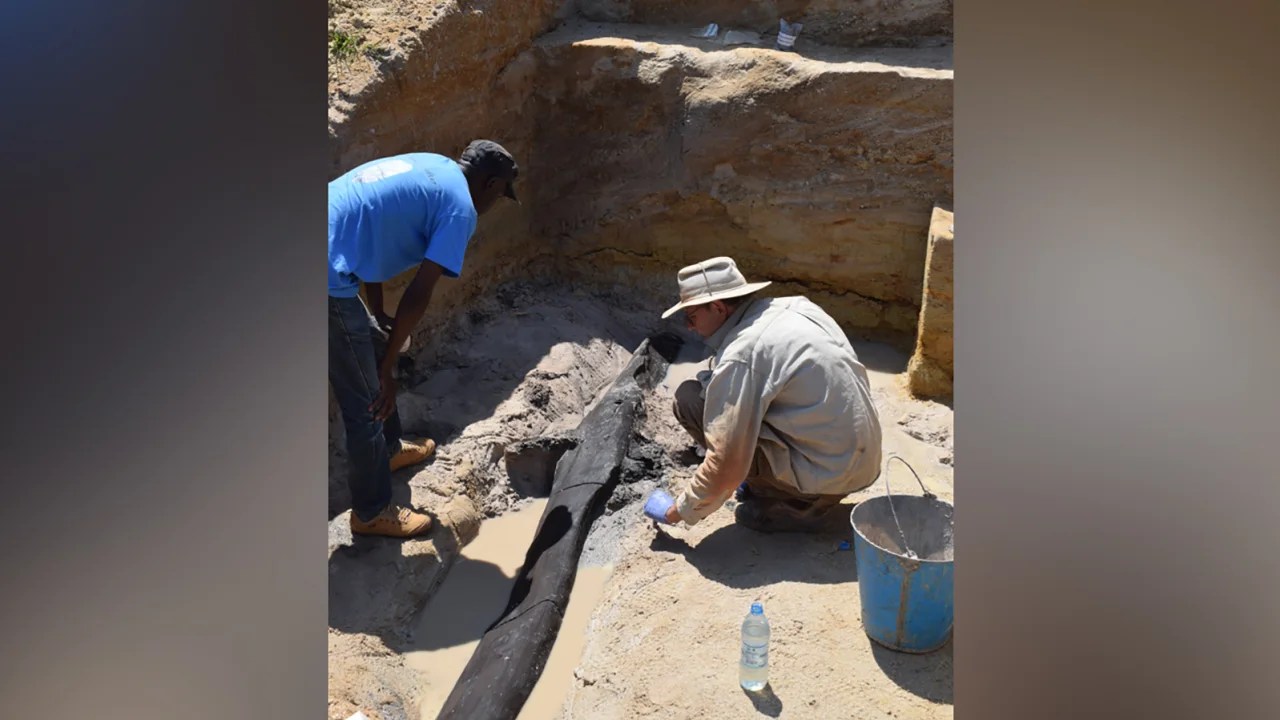(CNN) -- A group of archaeologists discovered the oldest known wooden structure, almost half a million years old.
The simple structure, found on the bank of a Zambian riverbank, is made up of two interlocking logs, with a notch purposely carved into the top piece to allow them to fit at right angles, according to a new study of cut marks made with stone tools.
- Stone Age humans wore cave bear skin 300,000 years ago
Geoff Duller, a professor of geography and earth sciences at Aberystwyth University in the United Kingdom, was part of the team that made the discovery in 2019. He said the structure, excavated upstream of Kalambo Falls near Zambia's border with Tanzania, would likely have been part of a wooden platform used as a walkway, to keep food or firewood dry or perhaps as a base on which a house was built. An excavation stick and other wooden tools were found at the same site.
"That the wood has remained in place and intact for half a million years is extraordinary. And it gives us this real insight, this window into this period of time," said Duller, co-author of the study on the timber structure that was published in the academic journal Nature on Wednesday.
"It has completely changed my view of what people were capable of at that time," he added.
Wooden artifacts are rarely preserved in the archaeological record, especially at such an ancient site, because organic material rots and disintegrates easily. In Kalambo, according to Duller, the high water levels and fine sediments that covered the structure helped preserve the wood.
advertising
- Ship missing from late nineteenth century discovered on Lake Michigan, says historical society
According to Duller, the discovery calls into question the prevailing view that Stone Age humans led a nomadic lifestyle. Kalambo Falls would have provided a reliable source of water and the surrounding forest abundant food, perhaps allowing for a more sedentary existence.
"At the very least, they put a lot of effort into this place," he said.
According to the study, the wooden structure has no real parallel in the archaeological record.
The wooden structure was found at an archaeological site upstream of Kalambo Falls in Zambia. Credit: Professor Geoff Duller/Aberystwyth University
The oldest known wooden artifact is a 780,000-year-old fragment of polished plank found at the site of Gesher Benot Ya'aqov, Israel, while the oldest known wooden foraging and hunting tools discovered in Europe date to about 400,000 years ago. Neanderthals are thought to have built structures with bones or stalactites about 175,000 years ago.
- "Treasures and secrets" discovered in sunken temple off the Egyptian coast
How was the structure made?
Duller compared the technique used to join parts of the structure to that of Lincoln Logs, the children's construction toy made of miniature logs that are fitted together by square notches. He said the two trunks were unlikely to come together naturally.
"Colleagues of ours made modern replicas of the stone tools we see and worked woods of similar density, and we can see that the shape of these marks is identical," Duller said. "So that's what makes us really sure (that) it's not a natural process: it was done intentionally using stone tools."
One of the four tools found at the site is shown. According to the researchers, this utensil was used to shape the wooden structure. Credit: Professor Larry Barham/University of Liverpool
The wooden pieces were too old to be dated directly with radiocarbon techniques. Instead, the team used a technique called luminescence dating, which involves measuring the natural radioactivity of minerals in the fine sediment that covered the wood to find out when it was last exposed to sunlight.
- Scientists say they identified the moment when humanity was on the verge of extinction
This dating method placed the structure at 476,000 years and determined that the four wooden tools – a wedge, a digging stick, a cut trunk and a notched branch – date back to 324,000 years ago. Researchers aren't sure which ancient human species made the wooden structure and tools, but it's highly unlikely it was ours. According to Duller, the earliest known fossils of Homo sapiens date to about 300,000 years ago and were found in what is now Israel.
According to him, the complexity of the structure suggests that the people who built it were cognitively sophisticated and able to draw up and execute a complex plan, something that likely required the use of language.
Larry Barham, professor of archaeology at the University of Liverpool, carefully uncovers the wooden structure of the riverbank with a fine sprayer. Credit: Professor Geoff Duller/Aberystwyth University
Archaeologist Dr. Annemieke Milks, a postdoctoral researcher at the University of Reading, UK, wrote in a commentary published alongside the research that the discovery revealed when people began to structurally alter the planet for their own benefit. The work also showed that a material widely used today played, as long suspected, an important role in the Stone Age.
"Studies like this highlight the role of this humble material in human history," said Milks, who was not involved in the research.
